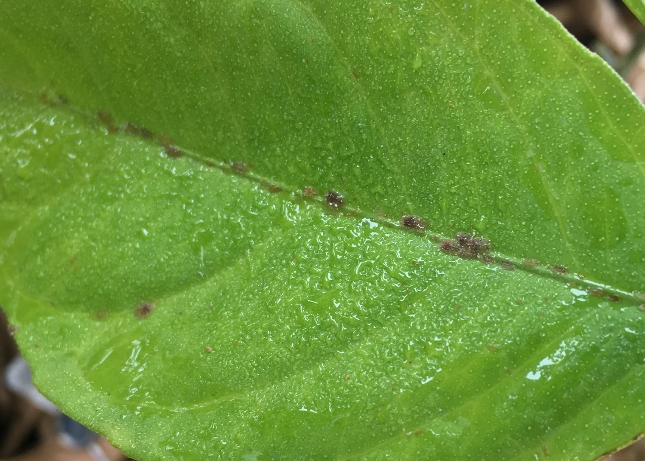A sticky substance on plant leaves, plant stands, and the floor are often the first clue alerting gardeners to a problem. If a closer look reveals bumps on the upper and lower surface of leaves and stems, it means scale insects have moved in to dine on your houseplants. Severe infestations can cause leaf yellowing, stunting and dieback of the plant.

If you have battled these insects, you know they can be challenging to control. Arm yourself with an understanding of their lifecycle and be persistent to successfully manage these pests.
Scale insects have needle-like mouthparts that allow them to pierce the leaf and stem surfaces. They suck plant sap through a tube-like structure just as if they were drinking from a straw. These are one of several insects that secrete drops of a clear, sticky substance, called honeydew, as they feed. A black fungus known as sooty mold may grow on the honeydew. It does not directly harm the plant, but it looks bad. In severe cases, sooty mold can prevent sunlight from reaching the leaves, causing them to yellow.
Adult scale insects form coverings that protect them from adverse environmental conditions and most chemical controls. Eggs hatch under this protective covering and the immature scale; called crawlers, emerge looking for a place to feed. Once settled, the crawler continues to grow, shedding layers of skin. These layers of shed skin, or waxy layers, form their protective covering.
Isolate infected plants as soon as you discover the problem. This will reduce the risk of this pest spreading to your other plants.
You can remove the adult scales with a toothpick, tweezers, or an old toothbrush. Repeat every few weeks until you have this pest under control. This may be sufficient to control small populations, but if you miss even one adult the problem persists.
The crawler stage is the most susceptible to chemical control. You will need a hand lens or magnifying glass to see these short-lived crawlers. Insecticides and washing small plants with a plant-safe soapy water solution can help manage small populations. Cover the pot and soil to prevent any scale knocked off during the bath from crawling back onto the plant.
You may be able to increase your chance of success with the help of an organic insecticide designed to control all stages of the scale insect, including the adult and eggs housed under the protective covering. Repeat applications are needed to get this insect under control.
Clean the pot, saucers, plant stands and the area around infected plants to remove any honeydew and unseen crawlers. This along with proper control will reduce the risk of these insects infesting treated and nearby plants.
Continue to monitor all your plants for scale and other insects each time you water. It is much easier to manage small populations than larger infestations on more plants.
Melinda Myers has written numerous books and hosts How to Grow Anything DVD series and the nationally-syndicated Melinda’s Garden Moment TV & radio program. Her website is MelindaMyers.com.
Related Articles & Free Vermont Maturity Subscription

Bring in the Birds with These Plants
Proper Landscaping Boosts Curb Appeal






Comment here